Bali SIM Card Guide: How to Stay Connected on Your Trip
Being in Bali without the internet feels like getting lost in the jungle without a map. Google Maps won’t load, messages won’t send, and mobile banking stays locked. Even booking a Gojek turns into a quest.
It’s better to get connected right away — before you even get into a taxi from the airport. This guide explains how to pick the best SIM card for Bali, which SIM or eSIM to choose, what mobile internet costs, and where the signal is strongest. You’ll also see how local deals compare to international ones — just in case buying an eSIM before your trip makes more sense.
Plus, there’s a handy list of what to do in Bali to test your connection on something more exciting than a speed test.
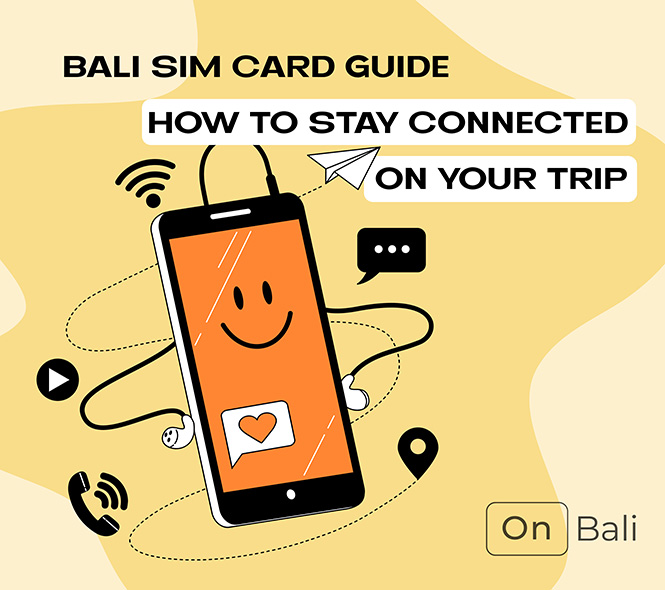
Why Get a Local SIM Card in Bali?
Sure, roaming might seem like the easiest option for a short trip. However, getting a Bali local SIM card is cheaper, faster, and more reliable. It gives you:
Unlimited data. Roaming burns through your plan in no time. With a local SIM, you get 20–30 GB for just $5–10.
Access to local services. You need an Indonesian number to sign up for Gojek or Grab. Drivers and couriers will also call or text you on that number. It’s often required when booking restaurants or tours.
Stable coverage. 4G works well in popular areas — especially with major providers like Telkomsel. Hotel Wi-Fi and roaming can’t always be trusted.
And if you’re staying longer, a local SIM isn’t just useful — it’s essential. Even for a two-week trip, it pays off on day one.
Where to Buy a SIM Card in Bali
Ngurah Rai International Airport
The fastest way to get connected is to buy a SIM card right after landing. In the arrivals hall, you'll see kiosks selling ready-to-use tourist packages. Staff will help you pick a plan, insert the SIM, and activate it on the spot.
✅ Pros. It's quick and easy — your internet is up and running when you get into a taxi.
❌ Cons. It's more expensive. You might pay US$15–20 for 25–30 GB, while the same package in town costs around US$5–10.
If convenience matters more than saving money, this option works just fine.
Local Convenience Stores and Official Retailers
You'll find SIM cards in minimarts, roadside stalls, and phone shops all over the island. But your best bet is to go to an official store.
There, you'll get:
honest pricing;
proper registration using your passport (which is mandatory)
help with setup if something doesn't work.
✅ Pros. Lower prices, more plans to choose from, everything done by the book.
❌ Cons. You'll need to find a store and spend a bit more time.
So, if you're still figuring out where to buy a SIM card in Bali, it comes down to how much time you have and what you're willing to spend. And if you're not in a rush, official retailers are the most cost-effective way.
Overview of SIM Card Providers in Bali
1. Telkomsel
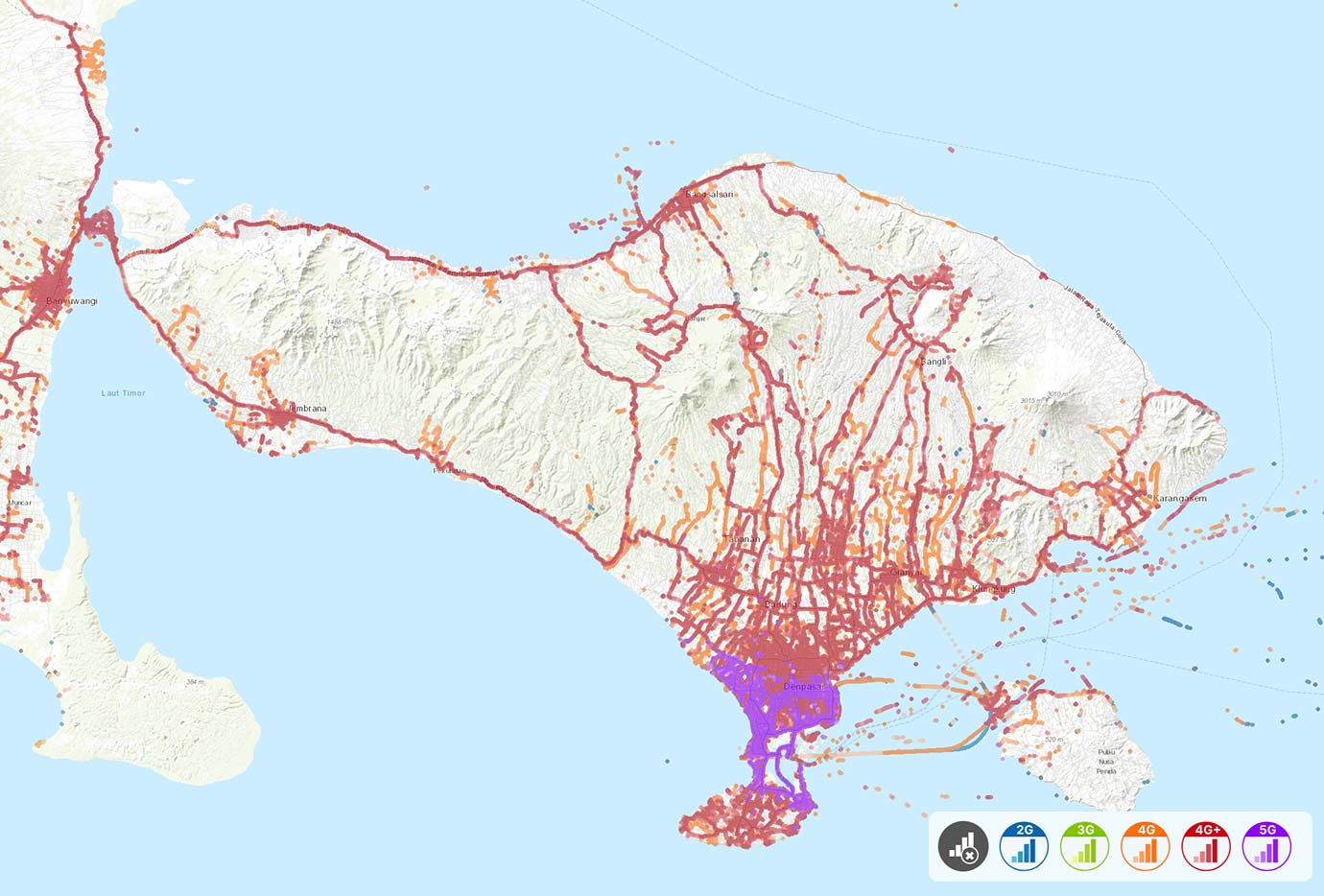 Coverage by Telkomsel
Coverage by TelkomselTelkomsel is the largest mobile operator in Indonesia, and it performs best in tourist areas and remote parts of the island. It keeps you connected in places like Uluwatu, the northern coast, and even in the mountains. If stable internet and wide coverage matter to you, this is the most reliable option — and, for many travelers, the best SIM card Bali has to offer.
Detailed Info about Telkomsel SIM cards
2. XL Axiata
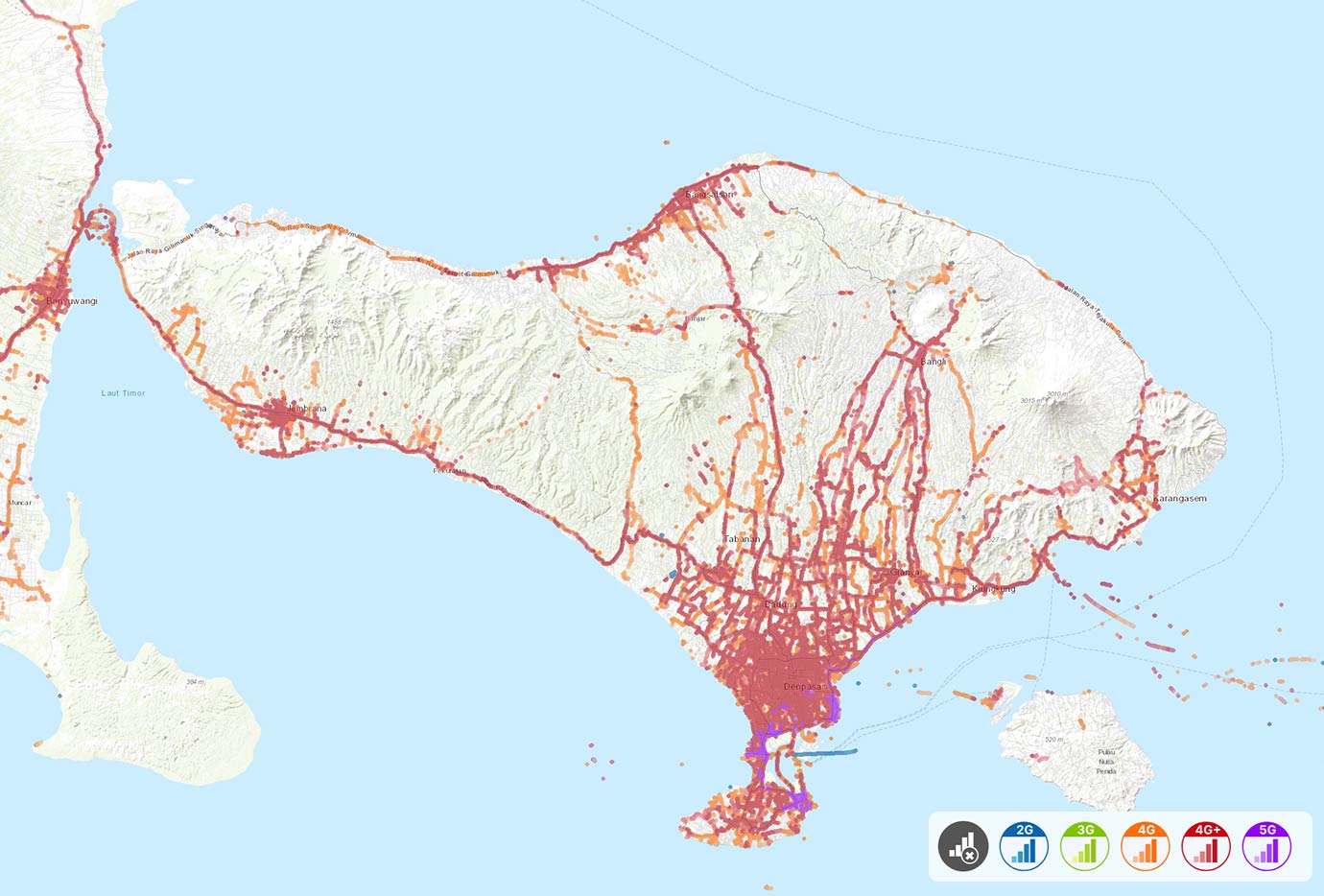 Coverage by XL Axiata
Coverage by XL AxiataXL is the second most popular mobile operator in Indonesia. It works well across Bali's tourist hubs, though coverage can drop off in remote areas. The pricing is slightly lower than that of Telkomsel, making it a solid choice for those who want to buy a SIM card in Bali on a budget.
Detailed Info about XL Axiata SIM cards
3. Indosat Ooredoo
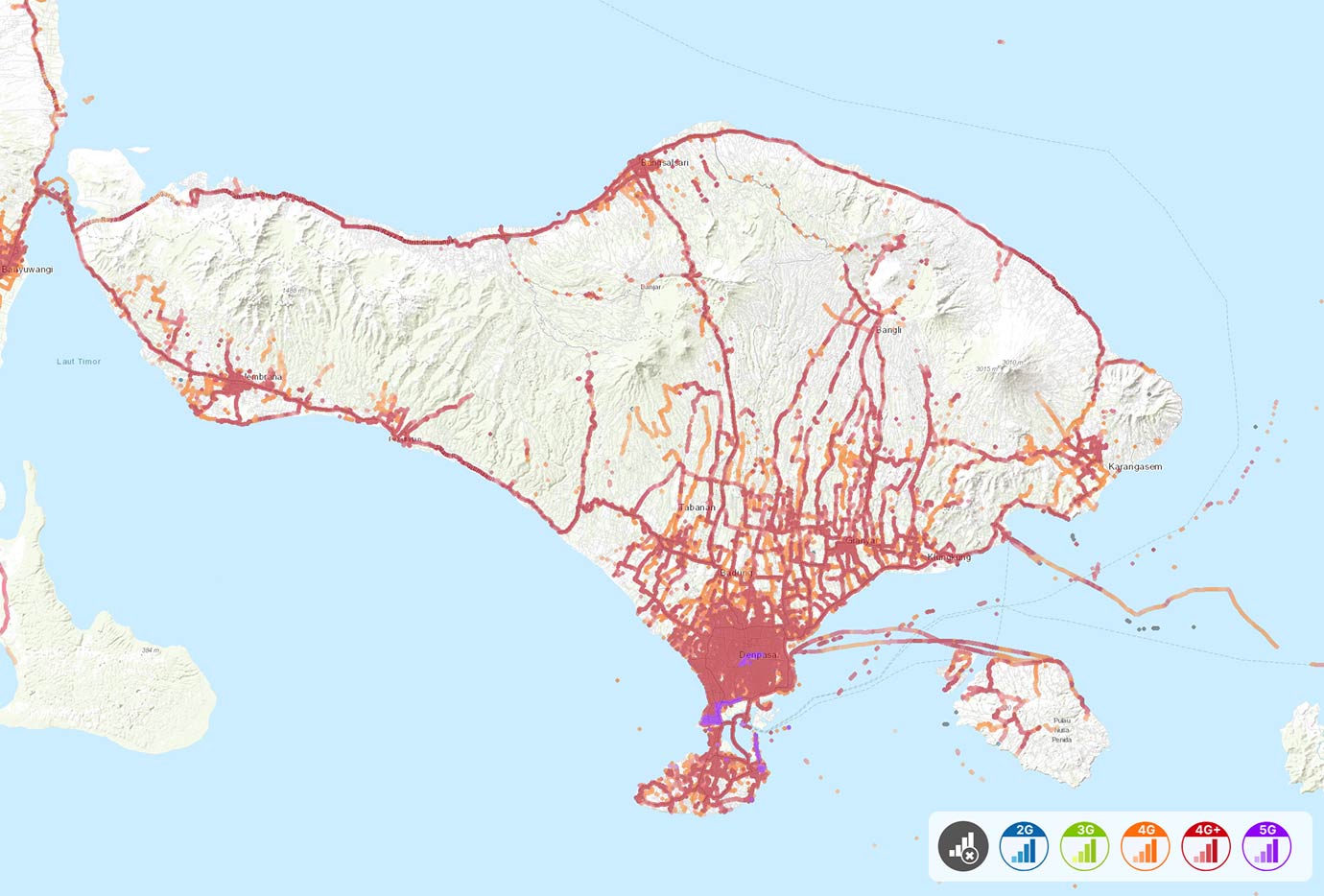 Coverage by Indosat Ooredoo
Coverage by Indosat OoredooIndosat is the third most popular operator in Indonesia. It offers some of the lowest prices on the island, though coverage isn't always reliable. If you're sticking to the city and don't need blazing speeds, this travel SIM for Bali could be a good fit.
Detailed Info about Indosat Ooredoo SIM cards
Here’s a quick comparison to help you choose the right Bali SIM card based on coverage, price, and internet speed.
Provider
Coverage
Internet Speed
Price for 25–30 GB
Best Coverage Areas
Best For
Telkomsel
⭐⭐⭐⭐⭐
⭐⭐⭐⭐
US$5–7
Entire island, including mountains and villages
Island-wide travel, stable connectivity
XL Axiata
⭐⭐⭐⭐
⭐⭐⭐
US$4–6
Ubud, Canggu, Seminyak, Denpasar
City stays, affordable combo packages
Indosat Ooredoo
⭐⭐
⭐⭐
US$3–5
Denpasar, Kuta
Budget trips and short stays
Understanding Data Plans and Packages
Mobile operators in Bali offer a range of packages depending on how you use your phone — just data, data plus calls, or something that looks unlimited. Whether you're after a simple Bali prepaid SIM card or need a bit more flexibility, here's what to expect.
Data-Only Packages
These are perfect if you mostly use messaging apps, maps, and social media — and rarely make phone calls.
Available from all major operators (Telkomsel, XL, Indosat)
Usually cheaper than combo plans
Data volume ranges from 10 to 50 GB
Example prices:
15 GB — from IDR 40,000 (approx. US$2.50)
30 GB — from IDR 70,000 (approx. US$4.50)
It is best for tourists, remote workers, and anyone who doesn't rely on voice calls.
Combo Plans
These include data, calls, and SMS — a good choice if you plan to call local numbers to book accommodation or reach drivers.
Often, they come with free minutes for same-network calls
Telkomsel and XL also offer extras like social media, YouTube, and messaging without using up your data
Example price:
25 GB + calls — from IDR 90,000 (approx. US$6)
Unlimited Data Options
If you're considering a Bali SIM card unlimited data deal, be aware that most aren't truly unlimited in practice. In most cases, this means:
Daily caps, with reduced speed after 1–2 GB
Unlimited access only to certain apps (like TikTok, YouTube, or WhatsApp)
Night-only access or time-limited usage
Telkomsel and XL offer semi-unlimited packages starting around IDR 100,000–150,000 (approx. US$6.50–10), but the fine print matters — always check the conditions.
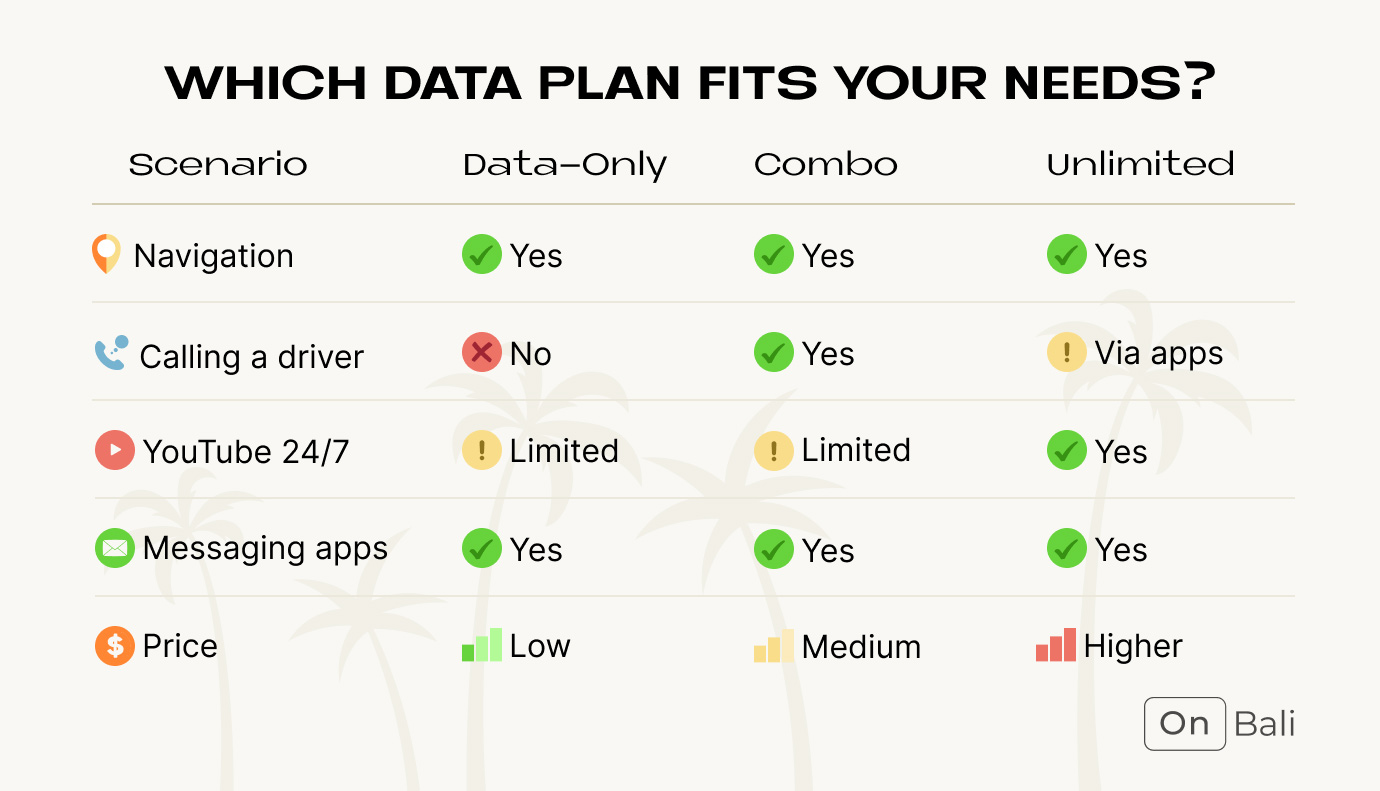
How to Top Up and Extend Your Data Plan
Running out of data doesn’t mean your SIM card stops working. You can top up and activate a new package right from your phone.
👉 Remember: there’s no automatic renewal like in some other countries. Once your plan runs out, the internet cuts off completely — until you activate a new one yourself.
If you’re getting a SIM card in Bali for the first time, it’s good to know how to keep it active — especially for longer stays.
Here’s how to do it:
Via the operator’s app. Download MyTelkomsel, myXL, or myIM3 — depending on your SIM card. You can check your balance, choose a new plan, and pay online.
At minimarts. Indomaret and Alfamart staff can help you top up — just mention your provider and give them your number.
With digital wallets. Topping up takes seconds if you have GoPay, OVO, or DANA. You’ll need a local card or account, though.
Using short codes. Some plans can be renewed via USSD codes. You’ll get them during activation or find them in the operator’s app.
Provider
App name
USSD
Telkomsel
MyTelkomsel
363#, 888#
XL Axiata
myXL
123#, 888#
Indosat Ooredo
myIM3
123#, 888#
How to Activate and Register Your SIM Card
When you buy a SIM card at an official store, it’s activated on the spot — linked to your passport and set up for the internet. The whole process usually takes just a couple of minutes. All you need is your ID.
Mobile data is typically enabled automatically. If not, the staff will help you set it up or give you a short activation code.
If your SIM isn't working, there's a good chance the temporary IMEI registration didn't go through. It happens — especially in smaller shops. We'll explain below how to check it and what to do next. This applies to local SIMs only — if you're using an international SIM card Bali travelers often get before arriving, IMEI registration isn’t required.
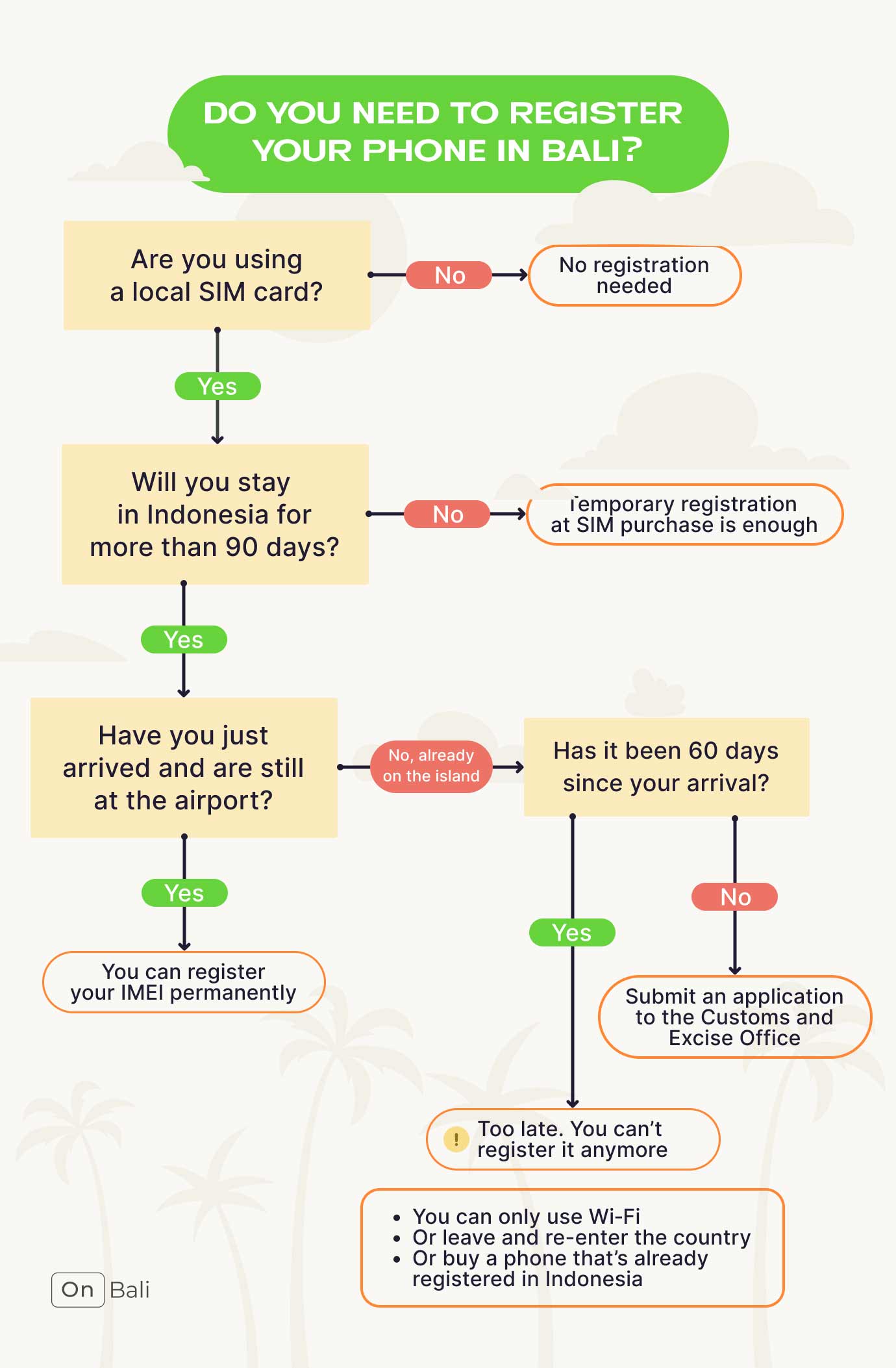
How Phone Registration Works in Bali
When you buy a SIM card at a phone store, the seller will ask for your passport and record your phone's IMEI — that's part of Indonesia's mandatory device registration system. Once it's done, your SIM will start working, and your phone will be temporarily registered.
IMEI is your device's unique identification number. Indonesian law requires all phones using local SIM cards to be registered in the system. It's aimed at preventing grey market imports and tracking illegal devices.
Temporary registration is done right at the store and is valid for up to 90 days — enough for most tourist visits. If you're staying longer, you'll need to register your device permanently.
👉 Long-term IMEI registration is only available at airports upon arrival in Indonesia. If you land in Soekarno-Hatta (Jakarta) and then fly to Ngurah Rai (Denpasar), you must register your device in Jakarta. Once you leave the arrivals area, you won't be able to do it anymore.
How does the process work, and what does it cost?
If your device is worth less than US$500, you won't need to pay anything. Just fill out a customs declaration and show your phone at the registration counter. If it's worth more, you'll have to pay a tax — roughly 40% of the amount above the US$500 threshold.
The whole thing takes about 10–15 minutes. You'll need your passport, boarding pass, and — if possible — a receipt for your phone.
If you stay in Indonesia longer than 90 days without completing permanent registration, your SIM will stop working. Your phone will lose connection to the local network — no calls, no data, no SMS. You'll still be able to use Wi‑Fi, but connecting to mobile services won't be possible anymore.
You can't fix this at a Customs and Excise Office — there's a 60-day window from the arrival date to complete the registration. After that, your options are:
Leave the country and come back, then register your IMEI at the airport during re-entry
Buy a new phone in Indonesia — it will already be registered
Technically, you can contact the Ministry of Communication and Information and register your phone there. Be aware that the import tax will apply regardless of the device’s value, not just when it exceeds US$500. Many say the process takes a long time, and you’ll be without mobile service while you wait.
There are also workarounds. I’m not recommending them, but many people use them anyway, especially in unexpected situations.
The most common option is to get a new SIM card every three months. To do that, go to a proper service center — not a street kiosk. And keep in mind: most providers only let you do this three times per operator.
Some go further and try to bribe store staff or use completely unofficial methods. These options carry risks and are best avoided.
Using eSIMs in Bali
An eSIM is a digital SIM card you can install on your phone without visiting a store. If your device supports it, getting connected takes just a few minutes: buy a plan from a provider like Airalo, Holafly, or Ubigi, scan the QR code — and you're online.
It's a great option if:
you want internet access before landing,
you don't need a local phone number,
and you're okay paying more for convenience.
But eSIMs do have limitations. First, they're more expensive — a 10–15 GB plan usually costs around US$15–20, while a Bali SIM card tourist package from a local provider costs about US$5–7. Second, you won't get an Indonesian number, so you can't use services like Gojek or Grab. And finally, if you're staying in the country for more than 90 days, you'll still need to register your IMEI — eSIMs don't bypass that rule.
To activate an eSIM, choose a provider, buy a plan on their website or app, and scan the QR code — and your internet will start working right away. Make sure to set it up before or just after arrival while you still have Wi‑Fi.
👉 Not all eSIM providers support all phones — always double-check compatibility before you pay.
By the way, Indonesian mobile operators are gradually rolling out eSIM support. According to local media, Bali may fully shift to digital SIMs in the coming years. Telkomsel and XL Axiata are already testing eSIMs in major cities, but for now, physical SIM cards remain the go-to option for most tourists.
Internet Coverage and Speeds in Bali
4G coverage in Bali is solid, especially around major tourist hubs. The signal is stable in Canggu, Seminyak, Ubud, and Nusa Dua, with typical speeds ranging from 20 to 50 Mbps — enough for video calls, social media, and maps.
Coverage can get spotty in more remote areas — like the north or the mountains — particularly with XL and Indosat. Telkomsel tends to be more reliable and often stays connected even when others drop out. If you plan to explore beyond the main towns, a strong Indonesia SIM card Bali travelers rely on — like Telkomsel — is your best bet.
Area or Location
Coverage & Speed
Notes
Canggu, Seminyak, Kuta
Good coverage, stable 4G
May slow down in the evenings
Ubud
Stable in the center, weaker on the edges
Telkomsel performs better here
Nusa Dua, Sanur
Very stable coverage
Great for work and video calls
Uluwatu and surroundings
Patchy signal in some areas
Choosing the right provider is crucial
North Bali (Lovina, Kintamani)
Weak signal, possible dropouts
Telkomsel is the only reliable option
Mountain areas and jungles
Signal may drop completely
Don’t count on having internet during hikes
Here are a few things to keep in mind:
Speeds may dip during peak hours (especially evenings in Canggu) — this is common, particularly with XL.
Hotel Wi‑Fi is often slow and unreliable. It's best not to count on it for work or streaming.
If a stable internet is essential (remote work, calls, meetings), have a backup — either Telkomsel or a combo of eSIM + local SIM.
Speeds also depend on your exact location and how crowded the network is. In popular areas like beaches and cafés, you might notice slowdowns when many users are online.
Tips for Staying Connected in Bali
Before your trip
While in Bali
Make sure your phone supports eSIM (if you plan to use one)
Buy your SIM card at an official store, not a street vendor
Download offline maps in Google Maps
Test your internet connection right after activation
Set up a VPN — you may need it to access banking apps and other services
If the SIM doesn't work, it might be an IMEI registration issue
Check out eSIM providers like Airalo, Holafly, and Ubigi
Use Telkomsel if you're traveling outside the main tourist areas
Learn about permanent IMEI registration if you're staying long-term
Register your IMEI upon arrival if staying more than 90 day
What to Do If You Lose Your SIM Card or Change Phones
Your SIM card is linked to both your number and the device in which it was activated. So, if you lose your phone or switch devices, things can get tricky.
If you lose your SIM:
Go to your operator's official store (Telkomsel, XL, or Indosat).
Bring the passport you used during registration.
You can recover your number, but only at an official sales point — and it might take some time.
If you're changing phones.
Keep in mind: in Indonesia, IMEI registration is tied to a specific device. If you move your SIM to a new phone that hasn't been registered, it won't connect to the network.
If it's been less than 90 days since activation, you can usually just transfer the SIM. But if you're staying long-term, you'll need to register the new phone's IMEI, which can only be done upon entering the country.
Expert opinion
If it's your first time in Bali and you want to avoid connection issues, stick with the basics: buy your SIM card at an official store, make sure it's activated on the spot, and download offline maps just in case. If your phone supports eSIM, set it up in advance — it's a great backup if there are delays or patchy coverage.
If you're still not sure what SIM card to buy in Bali, here’s a quick comparison of the main ways to stay connected:
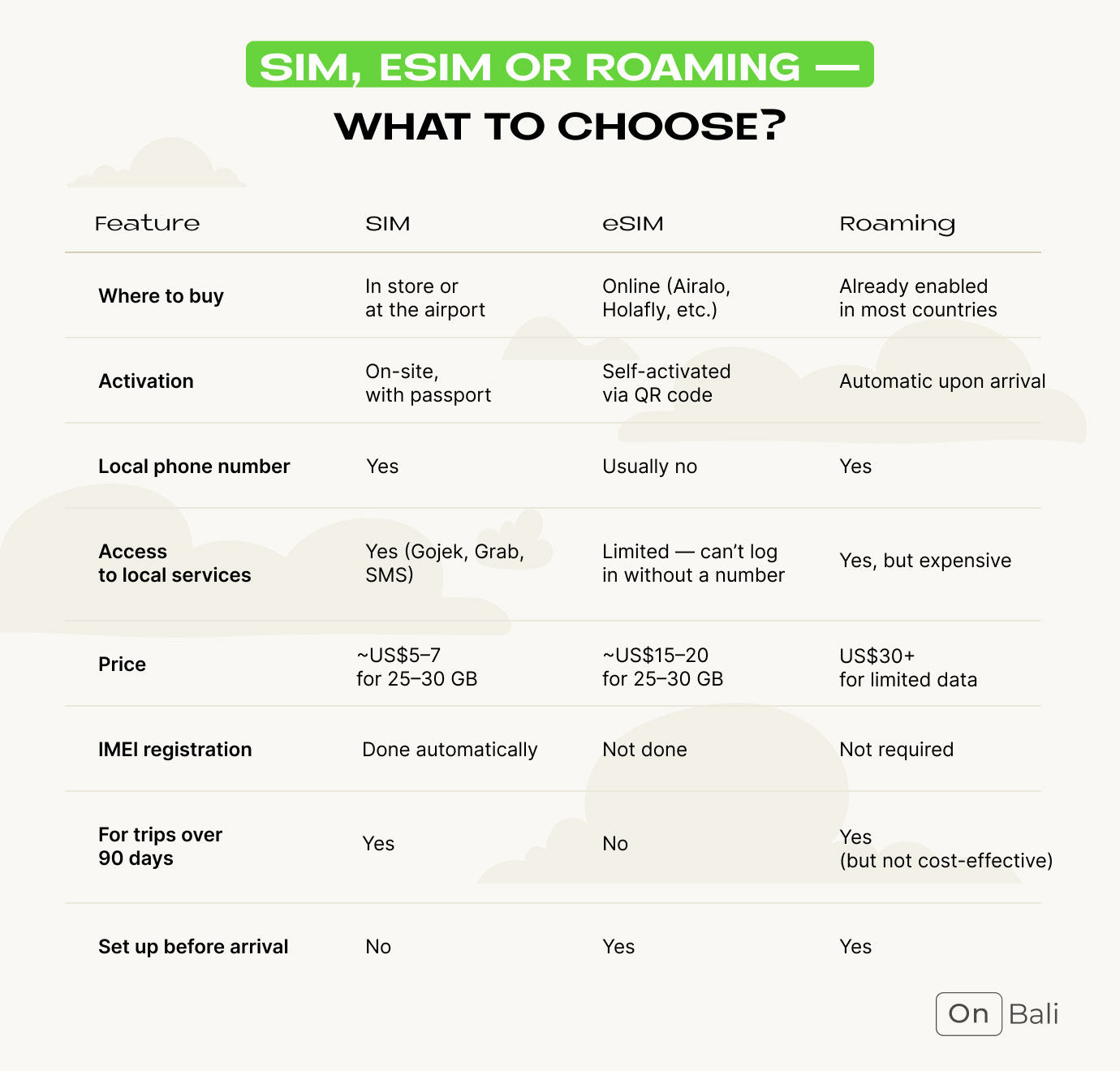
Before you wrap up your trip planning, take a look at the essentials:
Visa in Bali covers everything you need to enter the country without stress.
All about Wedding in Bali walks you through planning a ceremony on the island, from legalities to venues.
And for practical advice from those who’ve been there — Bali travel tips has it all.
Frequently Asked Questions
Telkomsel has the best coverage and most stable connection — especially if you plan to travel around the island.

Hi everyone! My name is Catur, and I was born and raised in Central Java. I moved to Bali in 2011 but left the island in 2016 before returning in 2018. Bali feels more than a home to me, and maybe that’s why my name feels like a premonition. Catur means four, both in the Balinese and Javanese languages. It is spoken like ‘c’ in chess, which is also the meaning of my name in Indonesian.







